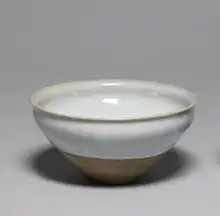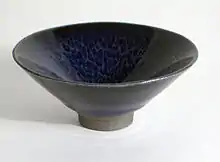Tenmoku
Tenmoku (天目, also spelled "temmoku" and "temoku") is a type of Japanese pottery and porcelain that originates in imitating Chinese stoneware Jian ware (建盏) of the southern Song dynasty (1127–1279),[1] original examples of which are also called tenmoku in Japan.

Shapes are simple and bold, with tea bowls the most typical. The emphasis is on the ceramic glaze, where a number of distinct effects can be produced, some including an element of randomness that has a philosophical appeal to the Japanese. The tea-masters who developed the Japanese tea ceremony promoted the aesthetic underlying tenmoku pottery.
History

Tenmoku takes its name from the Tianmu Mountain (天目Mandarin: tiān mù; Japanese: ten moku; English: Heaven's Eye) temple in China where iron-glazed bowls were used for tea.[2] The style became widely popular during the Song dynasty. In Chinese it is called Jian Zhan (建盏),[3] which means "Jian (tea)cup".[4][5]
According to chronicles in 1406, the Yongle Emperor (1360–1424) of the Ming dynasty sent ten Jian ware bowls to the shōgun Ashikaga Yoshimitsu (1358-1408), who ruled during the Muromachi period. A number of Japanese monks who traveled to monasteries in China also brought pieces back home.[6] As they became valued for tea ceremonies, more pieces were imported from China where they became highly prized goods. Three of these vessels from the southern Song dynasty are so highly valued that they were included by the government in the list of National Treasures of Japan (crafts: others).[5]
The style was eventually produced in Japan as well, where it endures until this day. The Japanese term gradually replaced the original Chinese one for general ware of the type. Of particular renown were the kilns that produced tenmoku are Seto ware.
The glaze is still produced in Japan amongst a very small circle of artists, one being Kamada Kōji (鎌田幸二).[7][8][9][10] Others are Nagae Sōkichi (長江惣吉),[11] Hayashi Kyōsuke (林恭助),[12][13][14] and Oketani Yasushi (桶谷寧).[15][16][17] Japanese artists have been helping in successfully re-introducing the technique back in China.[18][19]
Characteristics


It is made of feldspar, limestone, and iron oxide. The more quickly a piece is cooled, the blacker the glaze will be.
Tenmokus are known for their variability. During their heating and cooling, several factors influence the formation of iron crystals within the glaze. A long firing process and a clay body which is also heavily colored with iron increase the opportunity for iron from the clay to be drawn into the glaze. While the glaze is molten, iron can migrate within the glaze to form surface crystals, as in the "oil spot" glaze, or remain in solution deeper within the glaze for a rich glossy color. Oil spots are more common in an oxidation firing.[20]
A longer cooling time allows for maximum surface crystals. Potters can "fire down" a kiln to help achieve this effect. During a normal firing, the kiln is slowly brought to a maximum temperature by adding fuel, then fueling is stopped and the kiln is allowed to cool slowly by losing heat to the air around it. To fire down a kiln, the potter continues to add a limited amount of fuel after the maximum temperature is reached to slow the cooling process and keep the glazes molten for as long as possible.
Tenmoku glazes can range in color from dark plum (persimmon), to yellow, to brown, to black.
The two most common types of glaze are:[5]
- Youhen
- Yuteki
References
- "Jian ware - Chinese stoneware". Britannica.com. Retrieved 26 August 2018.
- "Tenmoku Teabowls - 京都国立博物館 - Kyoto National Museum". Kyohaku.go.jp. Retrieved 26 August 2018.
- Koh, N K. "Jian Temmoku bowls (Jian Zhan)". Koh-antique.com. Retrieved 26 August 2018.
- 1998-2012, Jan-Erik Nilsson, Gothenburg, copyright © Sweden. "Chinese Porcelain Glossary: Temmoku". Gotheborg.com. Retrieved 26 August 2018.CS1 maint: numeric names: authors list (link)
- "TENMOKU Menu - EY Net Japanese Pottery Primer". E-yakimono.net. Retrieved 26 August 2018.
- "Tea Drinking and Ceramic Tea Bowls - China Heritage Quarterly". Chinaheritagequarterly.org. Retrieved 26 August 2018.
- "Japanese Pottery - Artist Profile Kamada Koji". E-yakimono.net. Retrieved 26 August 2018.
- "京焼・清水焼作家 鎌田幸二 - ギャラリー洛中洛外". Rakuchu-rakugai.jp. Retrieved 26 August 2018.
- "展覧会 - 株式会社 アトリエ ヒロ". At-hiro.jp. Retrieved 26 August 2018.
- "鎌田幸二展 TENMOKU - 六々堂 - 京都・麩屋町二条". Rokurokudo.jp. Retrieved 26 August 2018.
- "9代長江惣吉さんが個展 「曜変天目」の最先端". Chunichi.co.jp. Retrieved 26 August 2018.
- "Pottery Reveals China and Japan's Shared Heritage". English.cri.cn. Retrieved 26 August 2018.
- "社団法人美濃陶芸協会". Mino-tougeikyoukai.org. Retrieved 26 August 2018.
- "曜変天目-銀座 黒田陶苑ー". YouTube. 26 July 2017. Retrieved 26 August 2018.
- "桶谷 寧 陶芸展 - 銀座 黒田陶苑". Kurodatouen.com. Retrieved 26 August 2018.
- "燿変天目茶碗 - ショップ - ギャラリー器館". G-utsuwakan.vom. Retrieved 26 August 2018.
- "中日仿曜变天目的陶艺家 - 鉴藏家 - 环球艺术汇". Gg-art.com. Retrieved 26 August 2018.
- "让全世界疯狂的建盏,究竟有什么魅力?-建盏君". Jianzhanjun.com. Retrieved 26 August 2018.
- Ceramics Monthly, "Oil Spot and Hare’s Fur Glazes: Demystifying Classic Ceramic Glazes", John Britt, April 13, 2011.
Further reading
- "The Complete Guide to High Fire Glazes", John Britt, Lark Books 2004, Oil Spot Glazes page 75 - 77.
External links
![]() Media related to Tenmoku at Wikimedia Commons
Media related to Tenmoku at Wikimedia Commons

